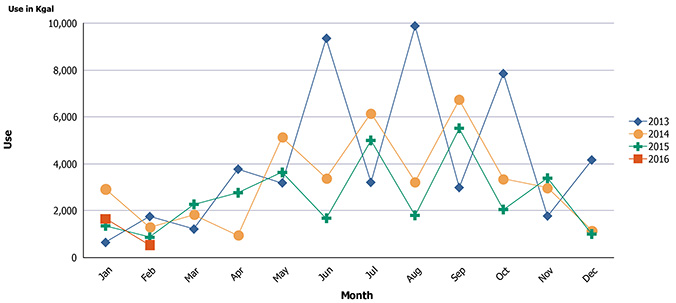CVHS reduced water usage in 2015
Although water conservation is a difficult issue to tackle, CVUSD reduced its total usage by 20 percent in 2015 compared to the previous year. This is a significant milestone considering that in 2014, Governor Jerry Brown called for all California residents to strive for exactly this amount of widespread reduction. The district’s usage began at a whopping 49,800 kilogallons in 2013, which then was reduced to 31,339 kilogallons in 2015.
The successful change comes from the management of the district maintenance staff that is in charge of monitoring this monthly usage across all 15 schools in the district. Maintenance leader Michael Miller urged students and teachers in a newsletter last year to look out for leaking faucets. He also laid out many methods for reducing usage, particularly in the summer months, which included irrigating and trimming fields less frequently.
Despite the decreasing trend in annual usage, Dr. Deborah Yager, a CVHS science teacher and advisor of the Smart Energy Club, sees plenty of opportunity for the schools to further improve these statistics.
“There’s always more we can do. For example, I noticed that in the women’s bathrooms, they are still using high-volume flush toilets. That’s one huge way to reduce the water. I see that every day and it bothers me,” said Yager.
AP Environmental Science teacher Nathan McCreary agreed with this concern, and even suggested using waterless urinals in the male restrooms. These devices have a draining system that chemically treats the waste as gravity leads it directly through the pipes, without the need to flush with water.
Irrigation of school grounds remains a big culprit of overall water usage, despite efforts to specifically target this area. The amount used during the first six months of the 2015-16 school year (September through February) show a surprising 24 percent increase from the corresponding months from the previous school year.
“It is surprising, but I am aware that the school needs to use water to keep dust down because that can be an issue. Then, of course, there’s also the fire hazard concern with underwatering, as well as just the aesthetic aspect of having watered lawns. It’s a complicated issue because we do still want to have our quality of life and to preserve the way the school looks, while saving water,” said McCreary.
Yager agreed, stating that even though it is a difficult balance of conflicting values, there are many more options that can still be explored for future improvements.
“The question is, how many fields? How much water should they be taking? What water sources can we use for irrigation besides potable water? I don’t know the answers to these questions, but these are the kinds of things that should be looked into,” Yager said.
Yager also explained that there is difficulty in maintaining enough custodians to monitor and speedily repair leaks and breaks that are commonly reported by students and teachers, often with many weeks passing before the repairs are made. When many custodians were laid off with budget cuts in previous years, the school district did not adjust to these changes.
“Twenty percent reduction a year is very significant. We can also try to reduce our individual water use by looking at where we use our water the most,” said McCreary. “Like when you shave and brush your teeth, is the water still running? That would be a simple way to reduce it.”

